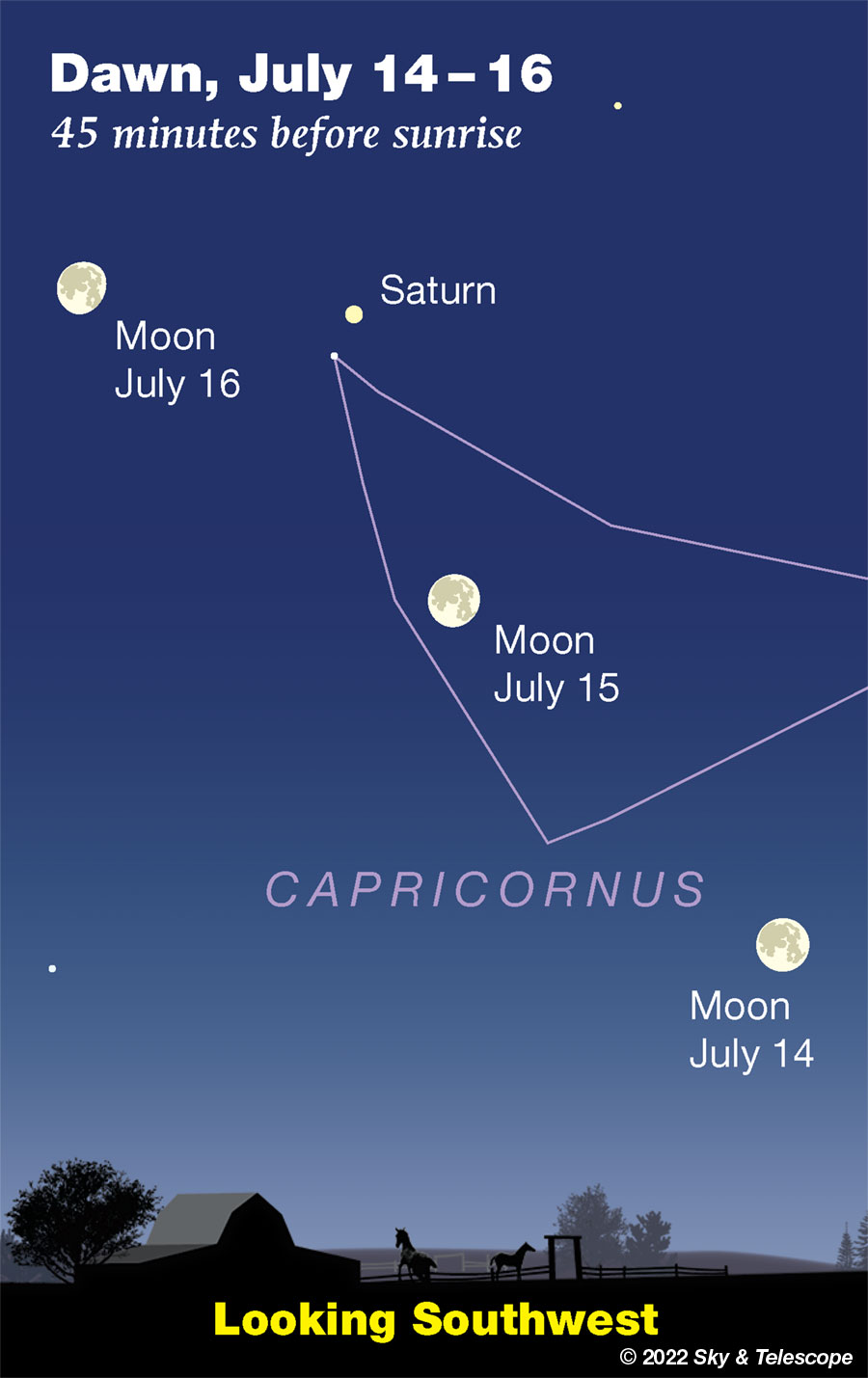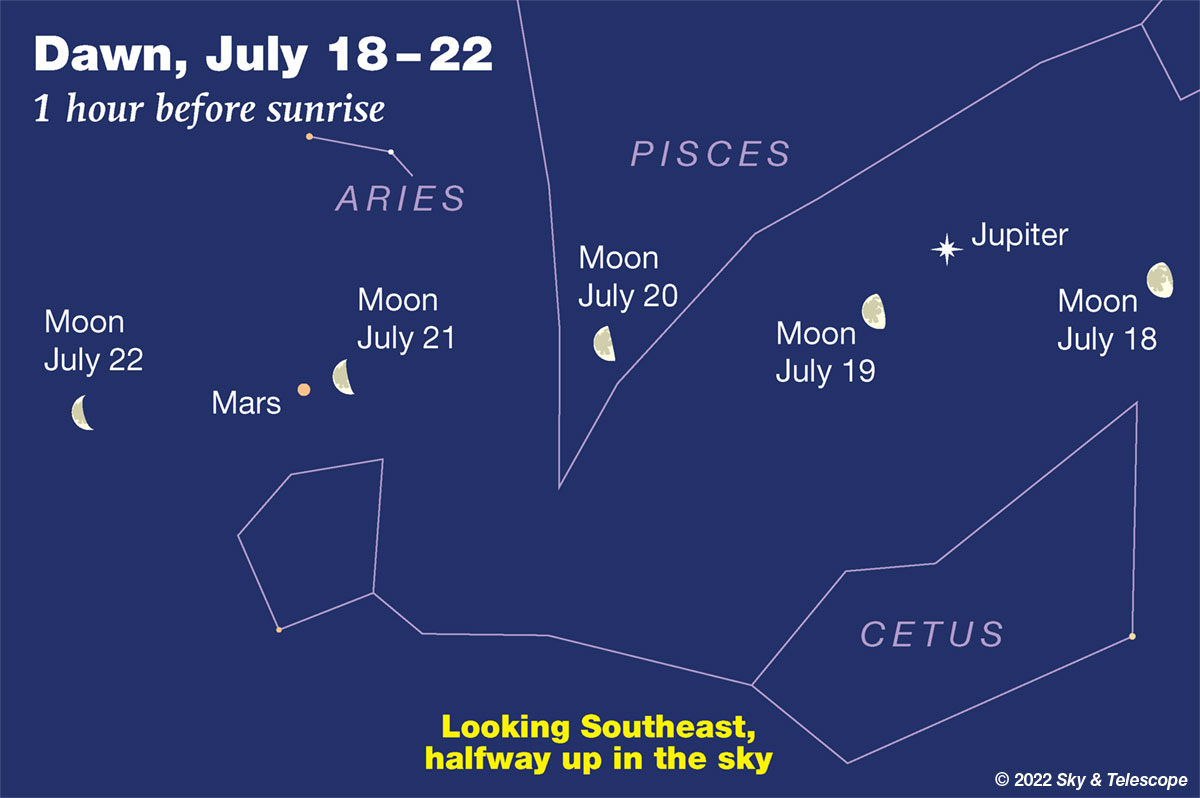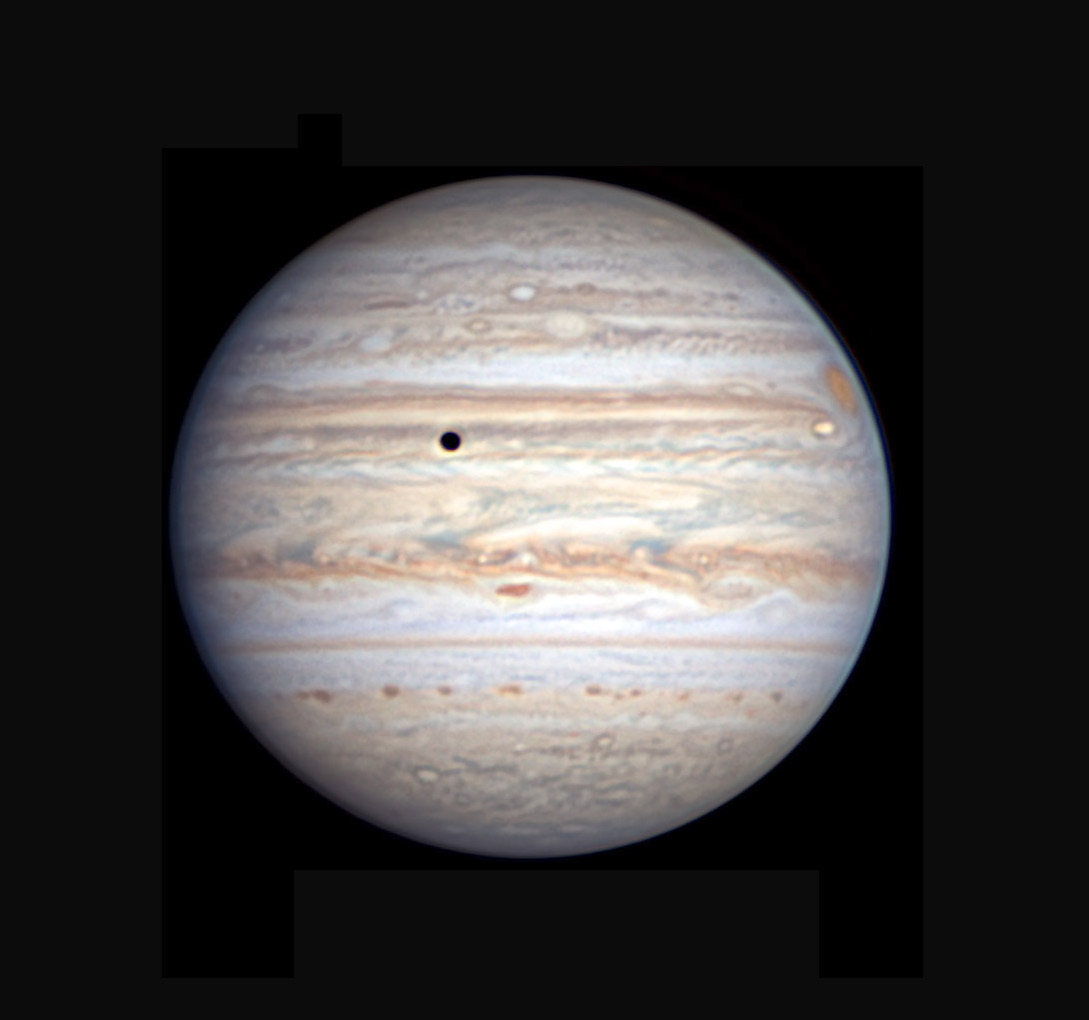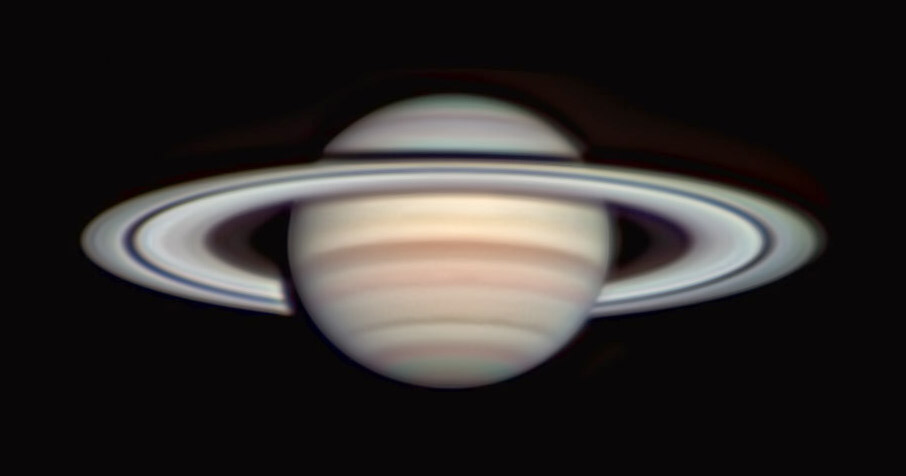FRIDAY, JULY 15
■ The waning gibbous Moon rises tonight around 10 p.m., with Saturn above it. Saturn is 3,700 times farther in the background.
They climb higher through the night and shine highest in the south before dawn on Saturday the 16th, with Saturn now to the Moon's right, as shown below.

SATURDAY, JULY 16
■ With the advance of summer, the Sagittarius Teapot now sits in the south-southeast after dark. It's about the apparent size of your fist at arm's length. The Teapot is just starting to tilt to the right as if to pour. The Teapot will tilt more and more for the rest of the summer — or for much of the night, if you stay out late.
■ To the lower right of the Teapot, the tail of Scorpius is low due south right after dark. How low depends on how far north or south you live: the farther south, the higher.
Look for the two stars especially close together in the tail. These are Lambda and fainter Upsilon Scorpii, known as the Cat's Eyes. They're canted at an angle; the cat has a bleary eye and is tilting its head to the right. (Lambda is brighter than Upsilon; they're magnitudes 1.6 and 2.6.) Both are blue-white supergiants, 700 and 500 light years away, respectively. Yes, the fainter one is nearer.
Between the Cat's Eyes and the Teapot's spout are the open star clusters M6 and especially M7, showy in binoculars.
A line through the Cat's Eyes points west (right) by nearly a fist-width toward Mu Scorpii, a much tighter pair known as the Little Cat's Eyes. They're oriented almost exactly the same way as Lambda and Upsilon, but they're only 0.1° apart. These two are not a true binary: they're 800 and 500 light-years away, respectively. And yes, the fainter one is the nearer of this pair also.
■ In the early morning hours of the 17th, the waning Moon shines about midway between Jupiter and Saturn.
SUNDAY, JULY 17
■ Face east after nightfall and look very high. The brightest star there is Vega. Look lower left of it, by two or three fists at arm's length, for Deneb, the brightest of Cygnus the Swan.
Far down below Deneb, the Great Square of Pegasus is coming up from below the horizon. After the end of twilight its bottom star is still not up, depending on your latitude. But give it another hour and all four will be in view. The Great Square — or "Great Diamond" in its current orientation — is about 15° on a side.
MONDAY, JULY 18
■ The Moon, nearly last quarter, rises due east around midnight tonight with Jupiter poised 3° or 4° above it. By dawn the Moon has moved a little farther from Jupiter — which now appears to its upper right, as shown below.

TUESDAY, JULY 19
■ Tonight the last-quarter Moon will rise around 12 or 1 a.m., with Jupiter now about 16° to its upper right. In another hour or more you can see that the Moon is between Jupiter and Mars. By Wednesday morning the 20th they're all high in the southeast, as shown above.
The Moon is exactly last quarter a few hours later, at 10:19 a.m. EDT on the 20th.
WEDNESDAY JULY 20
■ Arcturus and Vega are about equally far from the zenith in late twilight as the stars come out: Arcturus toward the southwest, Vega toward the east.
■ If you have a dark enough sky, the Milky Way forms a magnificent arch high across the whole eastern sky after nightfall is complete. It runs all the way from below Cassiopeia in the north-northeast, up and across Cygnus and the Summer Triangle high in the east, and down past the spout of the Sagittarius Teapot and the tail of Scorpius in the south.
THURSDAY, JULY 21
■ July is Scorpius month; the twisty constellation shines highest in the south after dark. Its brightest star is orange Antares. Other, whiter stars of Scorpius's upper part are around Antares and to its upper right. The rest of Scorpius runs down and then left.
Three stars to Antares's right form a roughly vertical line: they mark the head, or forehead, of the Scorpion. Counting down, they are Beta, Delta, and fainter Pi Scorpii.
Delta Sco, the middle one, is the brightest. It's an irregular variable star, a fast-rotating blue subgiant throwing off luminous gas from its equator. It has been found to have a smaller orbiting companion that seems to trigger activity at 10.5-year intervals. Assumed for centuries to be stable, Delta unexpectedly doubled in brightness in July 2000 and has remained nearly that bright, with fluctuations, for many of the years since. Astronomers are still waiting to see whether it will show new activity around now, as the companion makes its third pass by the primary star since 2000.
Delta Sco is currently about magnitude 1.9, pretty much where it has stayed for the last 11 years.
FRIDAY, JULY 22
■ Fourth star of the Summer Triangle. The next-brightest star near the Summer Triangle, if you want to turn it into a quadrilateral, is Rasalhague, the head of Ophiuchus, magnitude 2.0. Face south soon after dark. You'll find Rasalhague about equally far to the right of Altair and lower right of Vega. Altair is currently the Summer Triangle's lowest star. Vega, nearly overhead, is its brightest. The "Summer Quadrilateral" covers a little more than twice the area of the Summer Triangle.
■ Out real late this Friday night? By about 2 a.m. Saturday morning, the waning crescent Moon comes up in the east. Look just a few degrees above it for the Pleiades. As this panorama rises higher, watch for Aldebaran to rise into view farther below.
SATURDAY, JULY 23
■ Bright Arcturus is still pretty high after dark, but as summer progresses, it moves down the western side of the evening sky. Its pale ginger-ale tint always helps identify it. Off to its right is the Big Dipper.
Arcturus forms the bottom point of the Kite of Bo
This Week's Planet Roundup
Mercury is hidden in the glare of the Sun.
Venus, magnitude –3.9, continues to rise just as dawn begins. As dawn brightens, look for it low in the east-northeast. If dawn isn't too bright yet, try for orange Aldebaran increasingly far to Venus's upper right. And maybe even the Pleiades above Aldebaran. Brighter Capella shines farther to Venus's upper left.
Mars, magnitude +0.3 in Aries, rises around 1 a.m. and hangs high in the east-southeast as dawn begins. It's about three fists lower left of bright Jupiter. Mars is still very small in a telescope, 8 arcseconds in apparent diameter.
Jupiter, impressive at magnitude –2.6 (at the Pisces-Cetus border), rises due east around 11 or midnight. It's nearly at its highest in the south as dawn begins. It grows from 42 to 43 arcseconds wide this week.

On this side of the planet, the South Equatorial Belt is currently divided into two thin dark lines. The North Equatorial Belt looks more turbulent than we've seen it recently, and it hosts a tiny white outbreak (cloud upsurge) near the central meridian, just above a dark red barge in the North Tropical Zone.
Saturn, magnitude +0.4 in western Capricornus, rises in the east-southeast in late twilight. It's highest in the south for best telescopic viewing in the two hours before dawn. (Dawn begins now about 2 hours before sunrise.) Saturn's rings appear roughly as wide as Jupiter's disk.
The little star 1.3° or 1.4° below Saturn before dawn is Delta Capricorni, magnitude 2.8.

Uranus, magnitude 5.8 in Aries, is in the east before the first light of dawn, lower left of Mars.
Neptune, magnitude 7.9 at the Aquarius-Pisces border, is high in the south-southeast before the first light of dawn, right of Jupiter.
All descriptions that relate to your horizon — including the words up, down, right, and left — are written for the world's mid-northern latitudes. Descriptions and graphics that also depend on longitude (mainly Moon positions) are for North America.
Eastern Daylight Time, EDT, is Universal Time minus 4 hours. (Universal Time is also called UT, UTC, GMT or Z time.)
Want to become a better astronomer? Learn your way around the constellations. They're the key to locating everything fainter and deeper to hunt with binoculars or a telescope.
This is an outdoor nature hobby. For an easy-to-use constellation guide covering the whole evening sky, use the big monthly map in the center of each issue of Sky & Telescope, the essential magazine of astronomy.
Once you get a telescope, to put it to good use you'll need a detailed, large-scale sky atlas (set of charts). The basic standard is the Pocket Sky Atlas (in either the original or Jumbo Edition), which shows stars to magnitude 7.6.

Next up is the larger and deeper Sky Atlas 2000.0, plotting stars to magnitude 8.5; nearly three times as many. The next up, once you know your way around, are the even larger Interstellarum atlas (stars to magnitude 9.5) or Uranometria 2000.0 (stars to magnitude 9.75). And be sure to read How to Use a Star Chart with a Telescope. It applies just as much to charts on your phone or tablet as to charts on paper.
You'll also want a good deep-sky guidebook. A beloved old classic is the three-volume Burnham's Celestial Handbook. An impressive more modern one is the big Night Sky Observer's Guide set (2+ volumes) by Kepple and Sanner.
Can a computerized telescope replace charts? Not for beginners, I don't think, and not on mounts and tripods that are less than top-quality mechanically, meaning heavy and expensive. And as Terence Dickinson and Alan Dyer say in their Backyard Astronomer's Guide, "A full appreciation of the universe cannot come without developing the skills to find things in the sky and understanding how the sky works. This knowledge comes only by spending time under the stars with star maps in hand."
![]() Audio sky tour. Out under the evening sky with your
Audio sky tour. Out under the evening sky with your
earbuds in place, listen to Kelly Beatty's monthly
podcast tour of the heavens above. It's free.
"The dangers of not thinking clearly are much greater now than ever before. It's not that there's something new in our way of thinking, it's that credulous and confused thinking can be much more lethal in ways it was never before."
— Carl Sagan, 1996
"Facts are stubborn things."
— John Adams, 1770
 5
5









Comments
Anthony Barreiro
July 15, 2022 at 8:16 pm
Saturn is in eastern Capricornus.
You must be logged in to post a comment.
Rod
July 19, 2022 at 9:57 am
I came back from a trip to Dallas TX and a 100-acre, cattle ranch just outside Terrell TX. Dallas was near 108F yesterday 🙂 However, when I came down earlier on the cattle ranch, the stars after Full Moon on 13-July were lovely to see. Cygnus through Sagittarius and Scorpius much easier to see than my location. Terrell just below 33 degrees latitude compared to my location in MD. The latitude was more than 5 degrees below where I am at so Polaris lower elevation while Sagittarius and Scorpius, noticeably higher elevation viewing. Because the ranch was rural with no lights around and well east of Dallas, the Milky Way running from Cygnus down south, easier to see and more distinct. Good views to the north as well and western sky (big sky view). I estimate stars mv + 5.8 perhaps. There was a Celestron 60-mm refractor mounted on a wooden tripod at the ranch. I helped fix up and get working again. The finder scope was very small. Vega and Altair were not bright at all in the finder scope view. I wanted to view Jupiter early in the morning near 0400, no takers though, farm chores came near sunrise 🙂 I took in a Texas rodeo too 🙂
You must be logged in to post a comment.
mary beth
July 20, 2022 at 7:23 pm
Rod, I’m so glad you got to experience the “stars at night are big and bright deep in the heart of Texas“! That’s our little secret you know - the stars are actually bigger here!
You must be logged in to post a comment.
Rod
July 20, 2022 at 6:33 am
This morning skies clear at my location, so I did some quick, naked eye viewing. The nearly Last Quarter Moon was close to mid-way between Mars and Jupiter near the ecliptic, lovely sight. Last Quarter Moon today at 1419 UT or 1019 EDT according to July Sky & Telescope magazine, p. 42. The Moon in Pisces, Mars in Aries, and Jupiter in Cetus. I was tempted to get out my 90-mm refractor telescope and enjoy some early morning views but did not. The naked eye view was good enough before coffee 🙂
You must be logged in to post a comment.
Rod
July 20, 2022 at 6:34 am
This was 0445 EDT or 0845 UT.
You must be logged in to post a comment.
You must be logged in to post a comment.